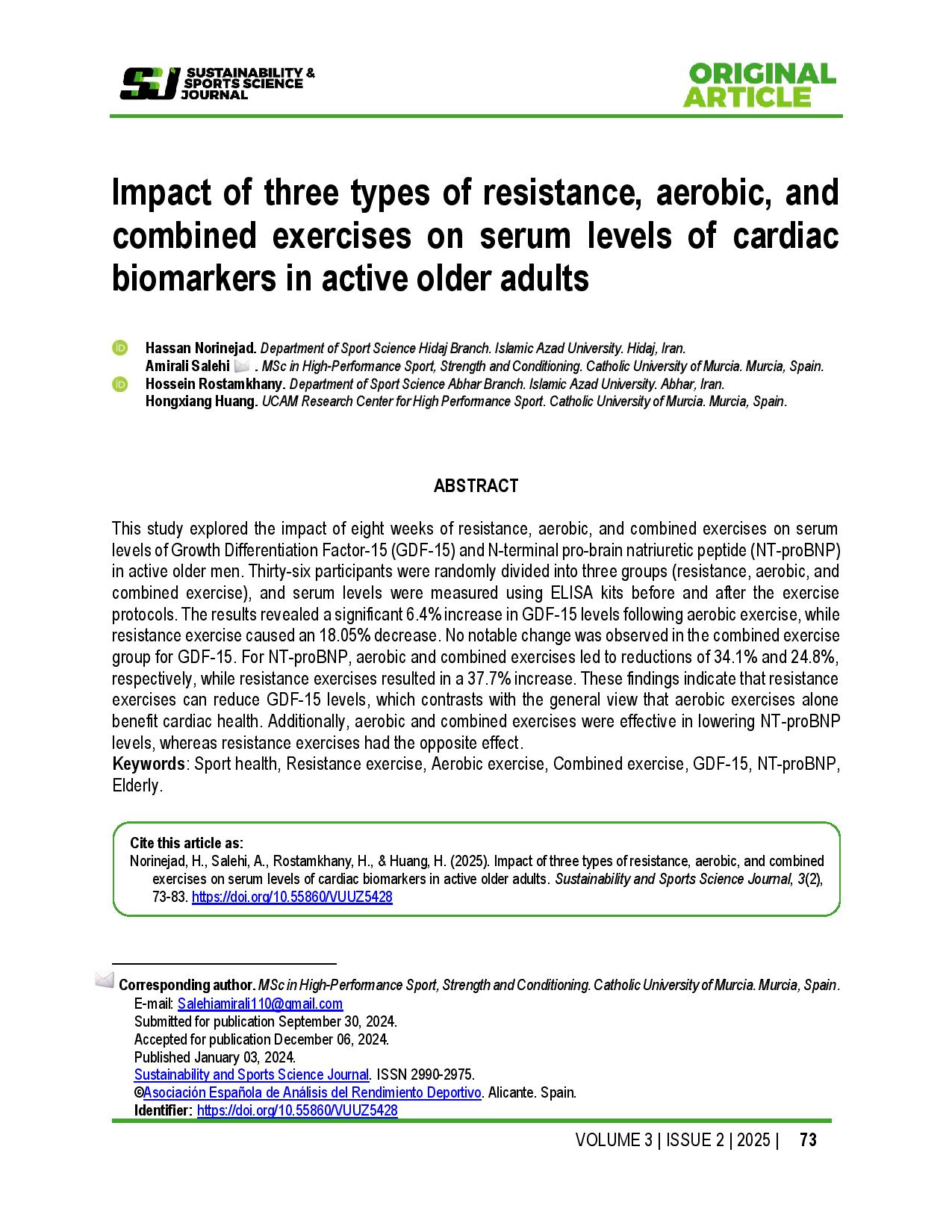Impact of three types of resistance, aerobic, and combined exercises on serum levels of cardiac biomarkers in active older adults
Main Article Content
Abstract
This study explored the impact of eight weeks of resistance, aerobic, and combined exercises on serum levels of Growth Differentiation Factor-15 (GDF-15) and N-terminal pro-brain natriuretic peptide (NT-proBNP) in active older men. Thirty-six participants were randomly divided into three groups (resistance, aerobic, and combined exercise), and serum levels were measured using ELISA kits before and after the exercise protocols. The results revealed a significant 6.4% increase in GDF-15 levels following aerobic exercise, while resistance exercise caused an 18.05% decrease. No notable change was observed in the combined exercise group for GDF-15. For NT-proBNP, aerobic and combined exercises led to reductions of 34.1% and 24.8%, respectively, while resistance exercises resulted in a 37.7% increase. These findings indicate that resistance exercises can reduce GDF-15 levels, which contrasts with the general view that aerobic exercises alone benefit cardiac health. Additionally, aerobic and combined exercises were effective in lowering NT-proBNP levels, whereas resistance exercises had the opposite effect.
Article Details

This work is licensed under a Creative Commons Attribution-NonCommercial-ShareAlike 4.0 International License.
References
Abete, P., Testa, G., Della-Morte, D., Gargiulo, G., Galizia, G., De Santis, D., & Cacciatore, F. (2013). Treatment for chronic heart failure in older people: Current practice and problems. Heart Failure Reviews, 18(4), 529-551. https://doi.org/10.1007/s10741-012-9363-6
Arbab, G., Nikparvar, M., Gaeini, A. A., & Sobhani, A. (2017). The effect of eight weeks of concurrent exercise on NT-proBNP and ferritin serum levels of beta thalassemia major patients. Bimonthly Journal of Hormozgan University of Medical Sciences, 20(1), 10-17.
Bordbar, S., Moghadasi, M., Babaei Beigi, M., Aslani, A., Rahimi, E. & GharehKhan, M. (2013). Comparison of acute and long-term effects of resistance and endurance training on brain natriuretic peptide levels in middle-aged men. Sports and Biological Sciences, 8(1), 8-42.
Christenson, R. H., Gottdiener, J. S., Kop, W. J., & Seliger, S. L. (2010). Dynamic cardiovascular risk assessment in older adults: The role of repeated N-terminal pro-B-type natriuretic peptide testing. Journal of the American College of Cardiology, 55(5), 441-450. https://doi.org/10.1016/j.jacc.2009.07.069
Ding, Q., Mracek, T., Gonzalez-Muniesa, P., Kos, K., Wilding, J., Trayhurn, P., et al. (2009). Identification of macrophage inhibitory cytokine-1 in adipose tissue and its secretion as an adipokine by human adipocytes. Endocrinology, 150(4), 1688-1696. https://doi.org/10.1210/en.2008-0952
Fábio, S., Lira, G., Pimentel, D., & Ronaldo, V. T. (2011). Exercise training improves sleep pattern and metabolic profile in elderly people in a time-dependent manner. Lipids in Health and Disease, 10, 113-124. https://doi.org/10.1186/1476-511X-10-113
Faviou, E., Zachari, A., Nounopoulos, C., Agrafiotis, E., Vourli, G., & Dionyssiou-Asteriou, A. (2008). Elevation of serum N-terminal pro-brain natriuretic peptide after exercise is an index of myocardial damage or a cytoprotective reflection? Journal of Sports Medicine and Physical Fitness, 48(1), 90.
Fadavi-Ghaffari, M., Azad, A., Meimandi, M., Arani-Kashani, Z., & Gorbanpoor, H. (2019). The psychometric properties of the Falls Efficacy Scale in elderly Iranian residents of nursing homes. Iranian Rehabilitation Journal, 17(3), 197-206. https://doi.org/10.32598/irj.17.3.197
Galliera, E., Lombardi, G., Marazzi, M. G., Grasso, D., Vianello, E., Pozzoni, R., et al. (2014). Acute exercise in elite rugby players increases the circulating level of the cardiovascular biomarker GDF-15. Scandinavian Journal of Clinical and Laboratory Investigation, 74(6), 492-499. https://doi.org/10.3109/00365513.2014.905697
Hofmann, M., Halper, B., Oesen, S., Franzke, B., Stuparits, P., Tschan, H., et al. (2015). Serum concentrations of insulin-like growth factor-1, members of the TGF-beta superfamily and follistatin do not reflect different stages of dynapenia and sarcopenia in elderly women. Experimental Gerontology, 64, 35-45. https://doi.org/10.1016/j.exger.2015.02.008
Jerome L. Fleg. Aerobic Exercise in the Elderly: A Key to Successful Aging. Specialty: Aging, Cardiology. Institution: Division of Cardiovascular Sciences. National Heart. Lung and Blood Institute, National Institutes of Health. Address, 2012; 6701- 20892.
Jurczyluk, J., Brown, D., & Stanley, K. K. (2003). Polarised secretion of cytokines in primary human microvascular endothelial cells is not dependent on N-linked glycosylation. Cell Biology International, 27(12), 997-1003. https://doi.org/10.1016/j.cellbi.2003.09.002
Kempf, T., Eden, M., Strelau, J., Naguib, M., Willenbockel, C., Tongers, J., et al. (2016). The transforming growth factor-β superfamily member growth-differentiation factor-15 protects the heart from ischemia/reperfusion injury. Circulation Research, 98(3), 351-360. https://doi.org/10.1161/01.RES.0000202805.73038.48
Lok, D. J., Klip, I. T., Lok, S. I., Badings, E., van Wijngaarden, J., Voors, A. A., & et al. (2013). Incremental predictive power of novel biomarkers (growth-differentiation factor-15, high-sensitivity C-reactive protein, galectin-3, and high-sensitivity troponin-T) in patients with advanced chronic heart failure. The American Journal of Cardiology, 112(6), 831-837. https://doi.org/10.1016/j.amjcard.2013.05.013
Punia, S., Sivachidambaram, K., & Varun, S. (2016). Effect of aerobic exercise training on blood pressure in Indians: A systematic review. International Journal of Chronic Diseases, 2016, 1370148. https://doi.org/10.1155/2016/1370148
Rangers, E., Mirzaei, B., & Rahmaninia, F. (2019). The effect of resistance training on serum levels of high sensitivity troponin I and GDF-15 in elderly men. Journal of Health Promotion Management, 6. https://doi.org/10.22049/JAHSSP.2022.27711.1449
Serrano‐Ostáriz, E., Terreros‐Blanco, J., Legaz‐Arrese, A., George, K., Shave, R., Bocos‐Terraz, P., et al. (2011). The impact of exercise duration and intensity on the release of cardiac biomarkers. Scandinavian Journal of Medicine & Science in Sports, 21(2), 244-249. https://doi.org/10.1111/j.1600-0838.2009.01042.x
Viviane, M., Paul, B., Johan, V., Manuella, M., Viviane, V. H., Cathe'rine, D. M., Nadine, P., Floris, L., & Christiaan, J. (2004). Combined endurance/resistance training reduces NT-proBNP levels in patients with chronic heart failure. European Heart Journal, 25, 1797-1805. https://doi.org/10.1016/j.ehj.2004.07.022
Xie, S., Lu, L., & Li, L. (2019). Growth differentiation factor-15 and the risk of cardiovascular diseases and all-cause mortality: A meta-analysis of prospective studies. Clinical Cardiology, 42(5), 513-523. https://doi.org/10.1002/clc.23159
Valls, M. R. B., Dimauro, I., Brunelli, A., Tranchita, E., Ciminelli, E., Caserotti, P., et al. (2014). Explosive type of moderate-resistance training induces functional, cardiovascular, and molecular adaptations in the elderly. Age, 36(2), 759-772. https://doi.org/10.1007/s11357-013-9584-1




